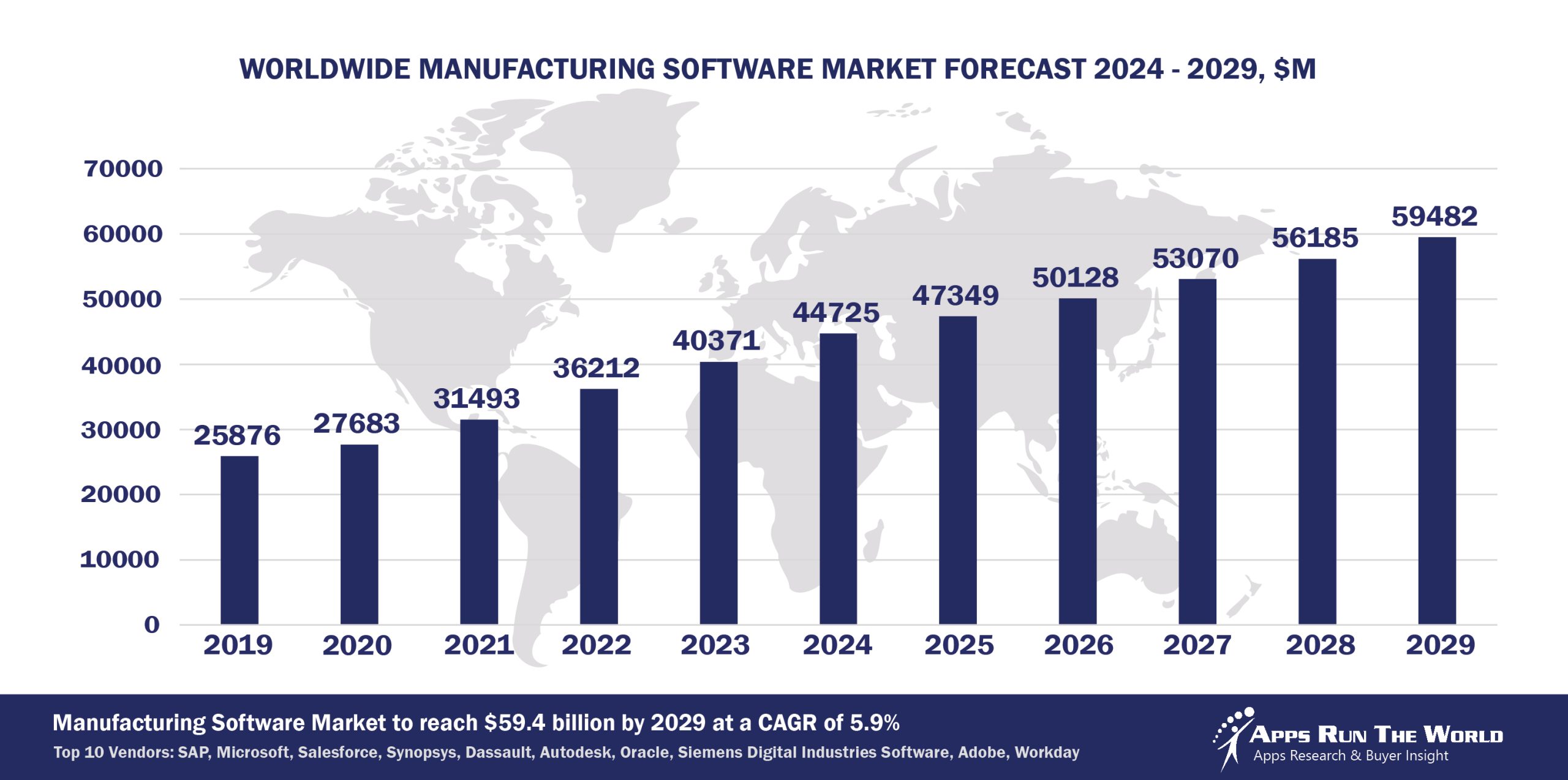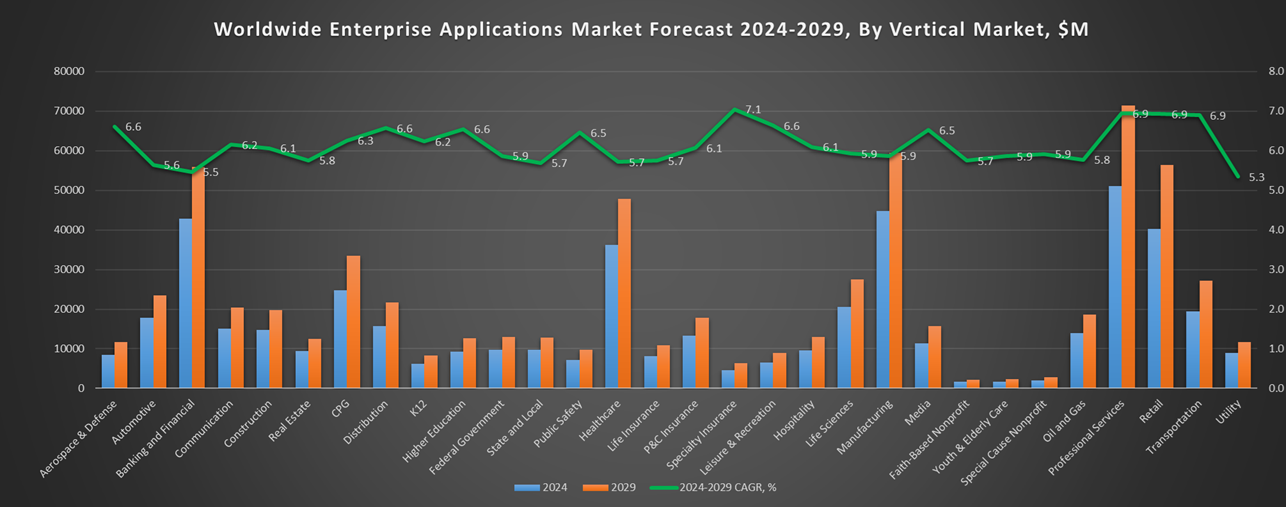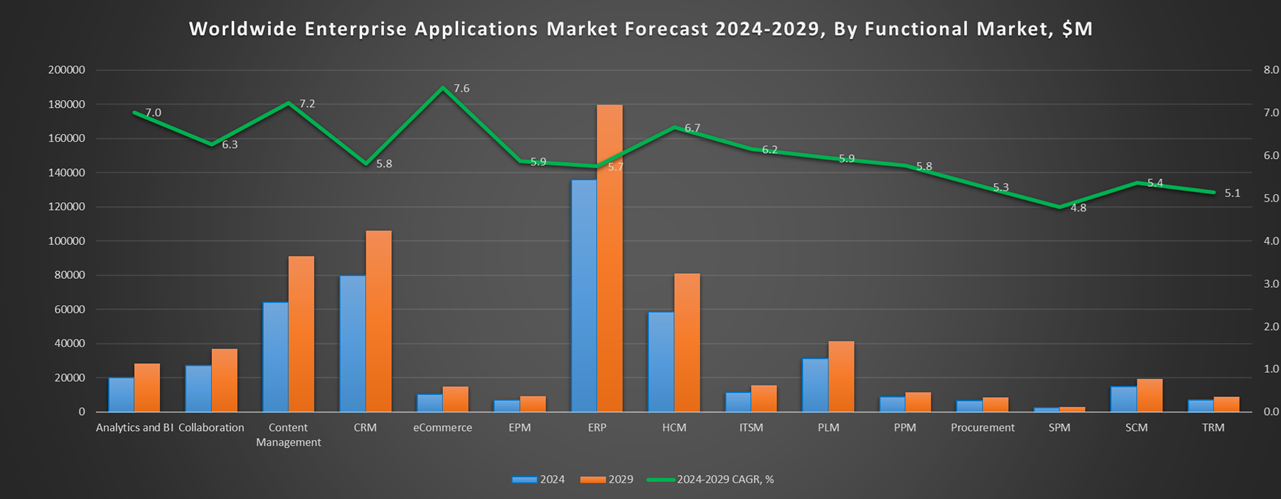
In 2024, the global Manufacturing software market grew to $44.7 billion, marking a 10.8% year-over-year increase. The top 10 vendors accounted for 46.7% of the total market. SAP led the pack with a 10.2% market share, followed by Microsoft, Salesforce, and Synopsys.
Through our forecast period, the Manufacturing applications market size is expected to reach $59.5 billion by 2029, compared with $44.7 billion in 2024 at a CAGR of 5.9%, as shown in the Apps Top 500 Report – Excel Edition [Preview] .
Manufacturing (Discrete, high-tech, process manufacturing) – Production Planning, Maintenance Management, Quality Management, CAD/CAM software, Manufacturing ERP, Manufacturing Execution System, Product lifecycle management, Financials, HR, Procurement
Top 10 Manufacturing Software Vendors in 2024 and their Market Shares
Source: Apps Run The World, July 2025
Other Manufacturing software providers included in the report are: Acumatica, Adobe, ADP, Altair Engineering, American Software, Ansys Inc., Aptean, Arkieva, Atlassian, AVEVA Group, Bentley Systems Inc., Cincom Systems Inc., Cadence Design Systems, Cisco Systems, Citrix, Constellation Software Inc., Content Guru, Dematic, DocuSign, Inc., Dropbox, E2open, Edgeverve, ECi Software Solutions, Epicor, GE Digital, Genesys Telecommunications Laboratories, Global Shop Solutions, Google, Hexagon, Honeywell International, HCL Technologies Ltd., IBM, IFS, Informatica, Infor, Intuit Inc., Johnson Controls, Kinaxis, Kingdee, Mark Information, Mercateo, OneStream Software, Open Text Corporation, PTC, Qlik, Ramco Systems, River Logic, Rockwell Automation, Roper Technologies, Sage, SAS Institute, ServiceNow, SYSPRO, Teradata Corporation, To-Increase, TopSolid, TOTVS, Trimble, Tugboat Software, UKG, Vendavo, Visma, Workcube ERP, Workday, Yonyou, Zoom Video Communications, and others.
Vendor Snapshot: Manufacturing Market Leaders
 SAP
SAP
SAP continues to expand its manufacturing suite through SAP Digital Manufacturing and SAP S/4HANA Manufacturing, focusing on real-time plant operations, automation, and predictive quality. The company integrates generative AI into production planning, asset insights, and supply chain collaboration using its Joule copilot across its applications. Recent investments emphasize closed-loop manufacturing and sustainability tracking, particularly through digital twin scenarios and industry-specific cloud offerings.
Microsoft
Microsoft advances its position in manufacturing with Microsoft Dynamics 365 Supply Chain Management and Finance, supporting smart factory operations with IoT, AI, and mixed reality integration. Azure’s AI and machine learning capabilities power predictive maintenance, supply forecasting, and robotic process automation across discrete and process industries. The company’s Copilot integration into Dynamics 365 enhances user productivity in demand planning, order management, and supplier communications.
Salesforce
Salesforce tailors its Manufacturing Cloud, built on core Sales Cloud and Service Cloud, to streamline customer forecasting, partner collaboration, and service management across the value chain. Its Einstein AI and Agentforce features automate sales agreements, forecasting, and field service operations. For marketing-driven demand generation, organizations integrate Marketing Cloud alongside Manufacturing Cloud via MuleSoft and Genie connectors, achieving unified CRM, marketing, and manufacturing process data.
Synopsys
Synopsys supports high-tech manufacturing environments through its TCAD, IP, and silicon lifecycle platforms, enabling simulation-driven development in semiconductor fabrication and embedded system design. AI is embedded in its EDA workflows to accelerate design-technology co-optimization and yield analytics. Strategic collaborations with foundries and system manufacturers support industrial innovation at the intersection of chip design and production scalability.
Dassault Systemes
Dassault Systemes delivers manufacturing-focused capabilities through the 3DEXPERIENCE platform, enabling model-based systems engineering, real-time production visibility, and supply chain simulation. The integration of AI into simulation, generative design, and virtual twin environments supports design-to-manufacturing continuity. Dassault’s DELMIA suite continues to be central to digital manufacturing transformation in automotive, aerospace, and industrial equipment sectors.
Autodesk
Autodesk enhances its support for smart manufacturing with Fusion 360 and Inventor, which integrate generative design, advanced simulation, and CAM capabilities. The platform uses AI to optimize product development cycles and automate geometry creation, targeting both discrete manufacturing and industrial design. Autodesk’s cloud-based architecture supports increased collaboration across engineering and fabrication workflows.
Oracle
Oracle strengthens its manufacturing capabilities with Oracle Fusion Cloud Manufacturing and NetSuite Advanced Manufacturing, offering integrated planning, MES, and shop floor execution. AI and analytics are embedded across production scheduling, inventory optimization, and quality control. The company continues to expand industry cloud modules tailored to discrete, process, and project-centric manufacturing operations.
Siemens Digital Industries Software
Siemens Digital Industries Software focuses on closed-loop digital twin capabilities through NX, Opcenter, and Teamcenter, linking design, simulation, and execution in manufacturing ecosystems. AI and machine learning enhance predictive quality, maintenance, and process optimization across the product lifecycle. Siemens continues to evolve its Industrial Edge and Xcelerator platform strategies to support flexible, software-defined manufacturing.
Adobe
Adobe supports manufacturing marketing and customer engagement through Adobe Experience Cloud, providing tools for product content management, personalization, and analytics. AI features such as Adobe Sensei automate campaign execution and behavioral targeting across digital channels. The platform helps industrial brands enhance dealer networks, B2B commerce, and customer lifetime value through unified data intelligence.
Workday
Workday extends its relevance in manufacturing through HCM, payroll, and analytics tools tailored to labor-intensive production environments. AI-driven workforce planning and skills mapping help manufacturers manage talent gaps, unionized workforces, and multi-location operations. Workday’s integration with supply chain systems enables holistic views of labor, cost, and productivity trends.
ARTW Technographics Platform: Manufacturing customer wins
Since 2010, our research team has been studying the patterns of Manufacturing software purchases, analyzing customer behavior and vendor performance through continuous win/loss analysis. Updated quarterly, the ARTW Technographics Platform provides deep insights into thousands of Manufacturing customer wins and losses, helping users monitor competitive shifts, evaluate vendor momentum, and make informed go-to-market decisions.
List of Manufacturing customers
Source: ARTW Buyer Insights Technographic Database
Custom data cuts related to the Manufacturing Applications market are available:
- Top 1000+ Manufacturing Applications Vendors and Market Forecast 2024-2029
- 2024 Manufacturing Applications Market By Functional Market (16 Markets)
- 2024 Manufacturing Applications Market By Country (USA + 45 countries)
- 2024 Manufacturing Applications Market By Region (Americas, EMEA, APAC)
- 2024 Manufacturing Applications Market By Revenue Type (License, Services, Hardware, Support and Maintenance, Cloud)
- 2024 Manufacturing Applications Market By Customer Size (revenue, employee count, asset)
- 2024 Manufacturing Applications Market By Channel (Direct vs Indirect)
- 2024 Manufacturing Applications Market By Product
Worldwide Enterprise Applications by Vertical Market
Exhibit 3 provides a forecast of the worldwide enterprise applications by vertical market from 2024 to 2029, highlighting market sizes, year-over-year growth, and compound annual growth rates across different industry sectors from Aerospace and Defense to Utilities.
Exhibit 3: Worldwide Enterprise Applications by Vertical Market Forecast 2024-2029 by Functional Market ($M)
Source: Apps Run The World, July 2025
Exhibit 4 shows our projections for the enterprise applications market by vertical segment, based on the buying preferences and the customer propensity to invest in new software within those industries as they continue to upgrade and replace many legacy industry-specific applications that have been identified and tracked in our Buyer Insight Database.


FAQ – APPS RUN THE WORLD Top 10 Manufacturing Software Vendors, Market Size & Forecast
Q1. What is the global Manufacturing software market size in 2024?
A: The global Manufacturing software market reached $44.7 billion in 2024, reflecting a 10.8% year-over-year increase driven by digital transformation and smart factory investments.
Q2. Who are the top 10 Manufacturing software vendors in 2024 and their combined share?
A: The top 10 vendors are SAP, Microsoft, Salesforce, Synopsys, Dassault Systèmes, Autodesk, Oracle, Siemens Digital Industries Software, Adobe, and Workday, collectively accounting for 46.7% of the global market.
Q3. Which vendor leads the Manufacturing software market in 2024?
A: SAP leads the Manufacturing software market in 2024 with a 10.2% market share, driven by its S/4HANA, digital supply chain, and Industry 4.0 offerings.
Q4. What is the forecast for the Manufacturing software market through 2029?
A: The Manufacturing software market is projected to reach $59.5 billion by 2029, growing at a 5.9% compound annual growth rate (CAGR) over the forecast period.
Q5. What software functions are included in the Manufacturing software market scope?
A: The market includes applications for product lifecycle management (PLM), manufacturing execution systems (MES), quality and maintenance, CAD/CAM, ERP, analytics, and workforce management.
Q6. Which other Manufacturing software vendors are covered beyond the top 10?
A: Additional vendors covered include PTC, Rockwell Automation, Epicor, Plex Systems, Aptean, Infor, Hexagon, and other emerging players in smart manufacturing.
Q7. When was this report published and by whom?
A: The Top 10 Manufacturing Software Vendors, Market Size & Forecast 2024–2029 was published in July 2025 by APPS RUN THE WORLD analysts as part of the APPS TOP 500 research program, which benchmarks the revenues and market share of the world’s 1,500+ largest enterprise application vendors.
More Enterprise Applications Research Findings
Based on the latest annual survey of 10,000+ enterprise software vendors, Apps Run The World is releasing a number of dedicated reports, which profile the world’s 1,500 largest Enterprise Applications Vendors ranked by their 2024 product revenues. Their 2024 results are being broken down, sorted and ranked across 16 functional areas (from Analytics and BI to Treasury and Risk Management) and by 21 vertical industries (from Aerospace to Utility), as shown in our Taxonomy. Further breakdowns by subvertical, country, company size, etc. are available as custom data cuts per special request.
Research Methodology
Each year our global team of researchers conduct an annual survey of thousands of enterprise software vendors by contacting them directly on their latest quarterly and annual revenues by country, functional area, and vertical market.
We supplement their written responses with our own primary research to determine quarterly and yearly growth rates, In addition to customer wins to ascertain whether these are net new purchases or expansions of existing implementations.
Another dimension of our proactive research process is through continuous improvement of our customer database, which stores more than one million records on the enterprise software landscape of over 2 million organizations around the world.
The database provides customer insight and contextual information on what types of enterprise software systems and other relevant technologies are they running and their propensity to invest further with their current or new suppliers as part of their overall IT transformation projects to stay competitive, fend off threats from disruptive forces, or comply with internal mandates to improve overall enterprise efficiency.
The result is a combination of supply-side data and demand-generation customer insight that allows our clients to better position themselves in anticipation of the next wave that will reshape the enterprise software marketplace for years to come.
- Telenor, a Norway based Communications organization with 16000 Employees
- Adept360 Australia, a Australia based Professional Services company with 25 Employees
- Evalueserve UK, a United Kingdom based Professional Services organization with 31 Employees
| Logo | Company | Industry | Employees | Revenue | Country | Evaluated |
|---|


 SAP
SAP